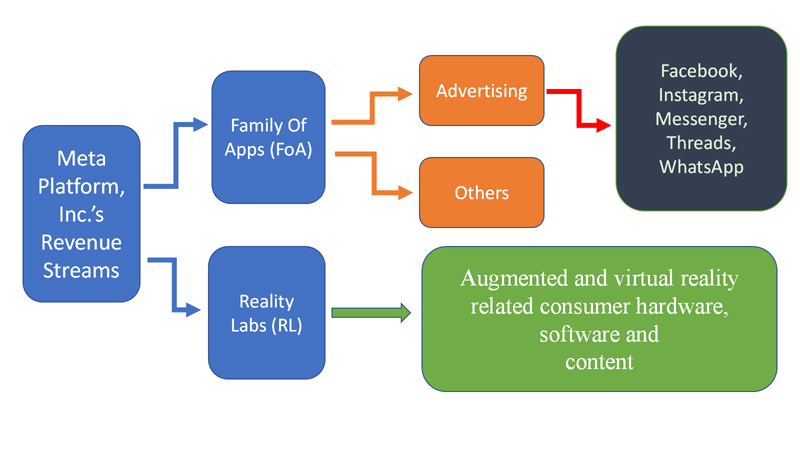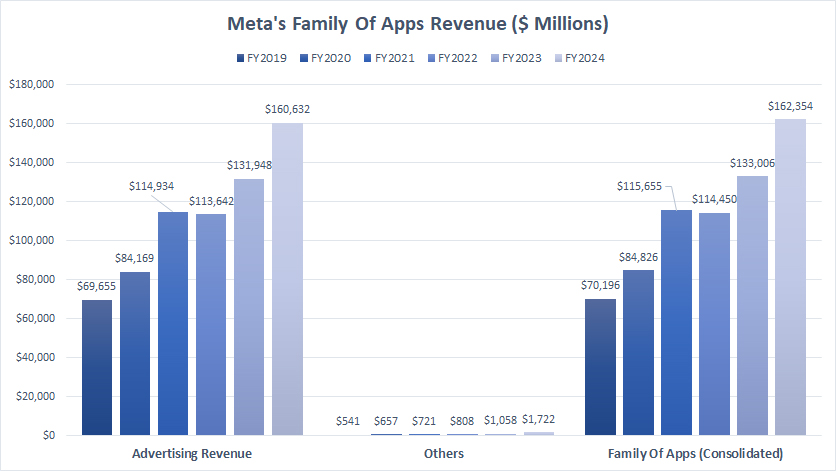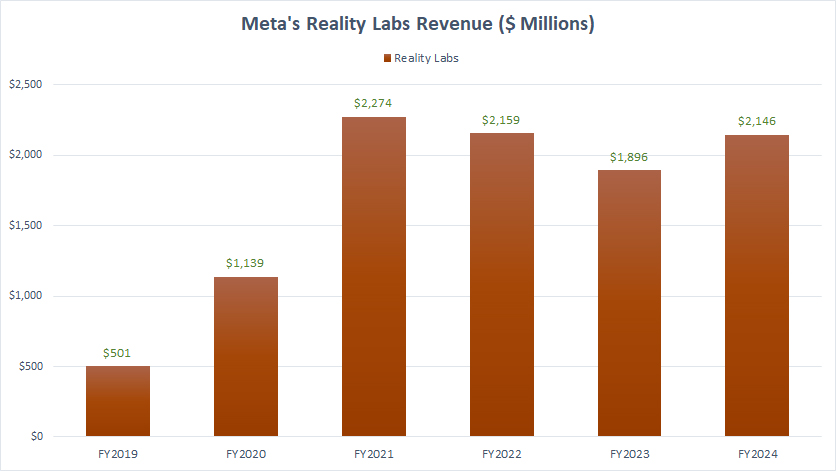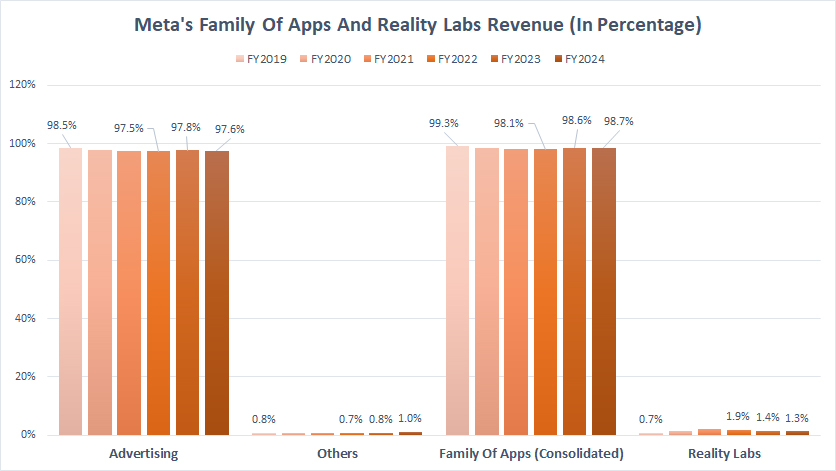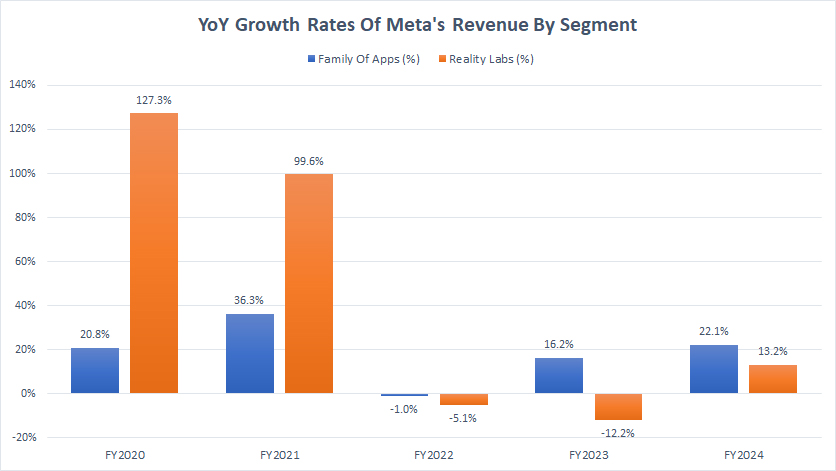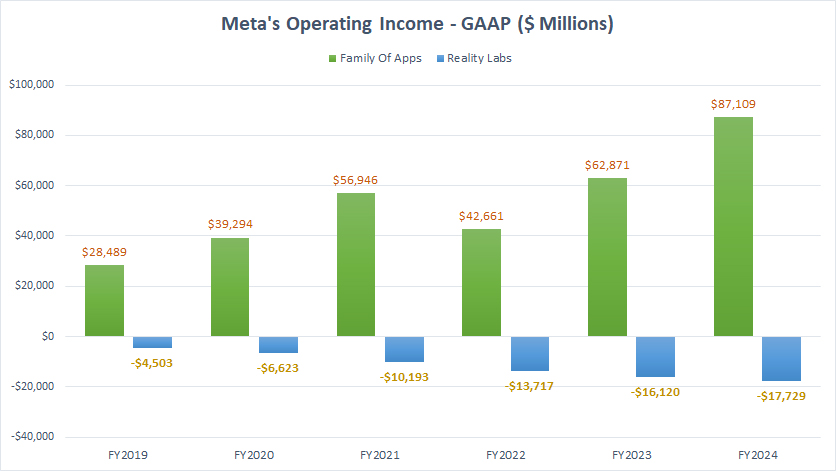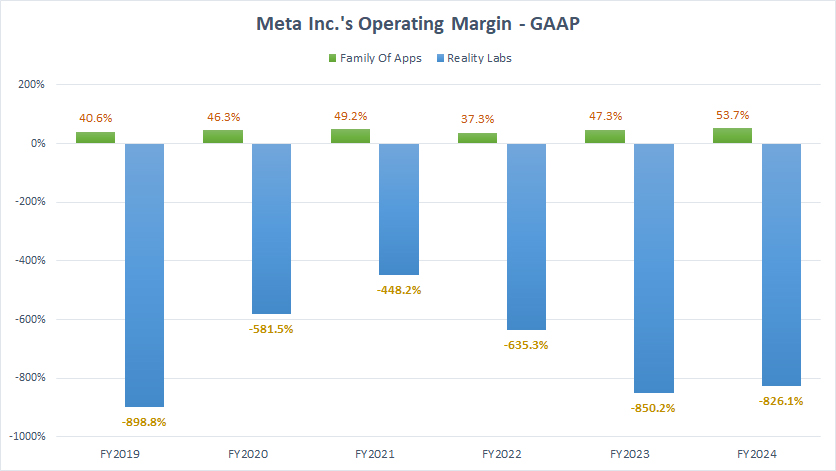
Meta’s Family Of Apps. Pixabay Image.
This article provides a comprehensive breakdown of the revenue segments for Meta Platforms, Inc. (NASDAQ: META). In addition to detailing revenue by segment, it also examines Meta’s profit and margins across these segments.
Meta’s revenue is divided into two primary segments: Family of Apps and Reality Labs. Let’s take a look.
You may find related statistic of Meta Platforms, Inc., on these pages:
- Meta revenue by country and region,
- Meta debt and cash vs Pinterest, Snapchat, and Twitter, and
- R&D comparison among Meta, Twitter, Pinterest, and Snapchat.
Please use the table of contents to navigate this page.
Table Of Contents
Definitions And Overview
O2. Meta Business Strategy
O3. How Does Meta Earn Revenue
Revenue By Segment
A1. Family Of Apps (FoA) Revenue
A2. Reality Labs (RL) Revenue
A3. FoA and RL Revenue In Percentage
A4. YoY Growth Rates Of FoA and RL Revenue
Profitability And Margin By Segment
B1. FoA and RL Operating Income
B2. FoA and RL Operating Margin
Conclusion And Reference
S1. Conclusion
S2. References and Credits
S3. Disclosure
Definitions
To help readers understand the content better, the following terms and glossaries have been provided.
Family Of Apps: Meta’s Family of Apps refers to the suite of social media and communication platforms owned by Meta Platforms (formerly Facebook Inc.).
This segment includes widely-used apps such as Facebook, Instagram, Messenger, WhatsApp, and Threads. These apps generate revenue primarily through advertising, connecting billions of users globally and offering various functionalities like photo and video sharing, messaging, and social networking.
Advertising Revenue: Meta’s advertising revenue primarily comes from ads displayed on its social media platforms, such as Facebook, Instagram, Messenger, and WhatsApp.
Advertisers pay Meta to display their ads to users based on various targeting criteria, including demographics, interests, and behaviors.
Meta uses sophisticated algorithms and artificial intelligence to optimize ad placements, ensuring that ads reach the most relevant audience.
This revenue stream is the backbone of Meta’s business model, accounting for the majority of its total revenue.
Reality Labs: Meta’s Reality Labs is a division of Meta Platforms (formerly Facebook Inc.) focusing on developing virtual reality (VR) and augmented reality (AR) hardware and software.
Formerly known as Oculus VR, Reality Labs produces products like the Meta Quest VR headsets and the Ray-Ban Stories smart glasses. The division is also involved in research and development efforts aimed at advancing technologies related to the metaverse and artificial intelligence (AI).
Other Revenue: Other revenue consists of revenue from WhatsApp Business Platform, net fees Meta receives from developers using its Payments infrastructure, and revenue from various other sources.
Meta Business Strategy
Meta aims to invest based on its priorities, focusing on six key investment areas: AI, the metaverse, discovery engine, monetization of products and services, regulatory readiness, and enhancing developer efficiency.
The company’s AI investments support initiatives across its products and services, helping power the systems that rank content in its apps, recommending relevant content, developing new generative AI experiences, and enhancing developer productivity.
Most of Meta’s investments are directed toward developing its family of apps, with significant investments in its metaverse efforts, including developing virtual and augmented reality devices, software for social platforms, neural interfaces, and other foundational technologies.
Despite operating at a loss for the foreseeable future in the Reality Labs segment, Meta believes investing in the metaverse will unlock monetization opportunities for businesses, developers, and creators, including advertising, hardware, and digital goods.
How Does Meta Earn Revenue
Meta revenue streams
(click image to expand)
Meta Platforms, Inc.’s (META) revenue streams consist of two segments: Family Of Apps (FoA) and Reaility Labs (RL).
The definitions of Meta’s segments are available here: Family Of Apps and Reality Labs.
Meta’s Family of Apps generates revenue primarily from selling advertising placements to marketers. These marketers purchase ads that can appear across various platforms, including Facebook, Instagram, Messenger, Threads, and third-party applications and websites.
In contrast, Reality Labs reflects Meta’s efforts to develop the metaverse and derives its revenue from sales of consumer hardware products, software, and content.
These offerings encompass augmented and virtual reality-related consumer hardware, software, and content designed to help people stay connected anytime, anywhere.
The Meta Quest is a prime example of such products and services, enabling friends and families to stay connected and share meaningful moments through state-of-the-art VR hardware, software, and content.
With its advanced technology, Meta Quest offers an immersive experience that enhances communication and interaction, making it easier for users to connect and engage with loved ones in new and exciting ways.
Family Of Apps (FoA) Revenue
Family Of Apps Revenue
(click image to expand)
The definitions of FoA, advertising and other revenue are available here: Family Of Apps, advertising revenue, and other revenue.
The Family of Apps (FoA) is a major segment of Meta Platforms, Inc., generating the bulk of its revenue from advertising.
According to the chart above, advertising revenue constitutes the lion’s share of FoA’s consolidated income. In the year ending December 31, 2024, Meta’s FoA achieved $160.6 billion in advertising revenue, a substantial increase from the $131.9 billion recorded the previous year.
In contrast, Meta’s other revenue within the FoA sector amounted to just $1.7 billion in fiscal year 2024, appearing almost negligible compared to the dominant advertising revenue.
Overall, the combined revenue streams within Meta’s Family of Apps segment reached $162.4 billion in fiscal year 2024.
This marked a significant growth from the $133.0 billion reported in fiscal year 2023, highlighting the strong performance and continued expansion of Meta’s Family of Apps.
Meta has been actively investing in enhancing its Family of Apps by integrating advanced technologies such as artificial intelligence, machine learning, and augmented reality.
These investments aim to improve user experience, increase engagement, and provide more targeted advertising solutions.
Features like Instagram Reels, Facebook Stories, and enhanced messaging capabilities have contributed to higher user engagement, which in turn boosts advertising revenue.
Reality Labs (RL) Revenue
Reality Labs Revenue
(click image to expand)
Meta’s Reality Labs (RL) is the division responsible for developing the metaverse. The definitions of RL are available here: Reality Labs.
Although Reality Labs’ revenue was significantly smaller than that of Family of Apps, it still reached $2.1 billion in fiscal year 2024.
A noticeable trend is that Reality Labs’ revenue likely peaked at $2.4 billion in fiscal year 2021. However, it experienced a significant decline, dropping to $1.9 billion in fiscal year 2023 before recovering slightly to $2.1 billion in fiscal year 2024.
Despite the revenue fluctuations between fiscal years 2021 and 2024, Reality Labs has seen remarkable growth, with its revenue increasing by more than 300% since 2019.
This impressive growth can be attributed to Meta’s continuous investment in cutting-edge technologies and innovative products in the realm of virtual and augmented reality.
Products such as the Meta Quest VR headsets and the Ray-Ban Stories smart glasses have contributed to this growth, attracting consumers interested in immersive experiences.
Reality Labs’ focus on developing the metaverse, a virtual space where people can interact and connect in a digital environment, has also played a crucial role in driving revenue growth.
By creating a comprehensive ecosystem of hardware, software, and content, Meta aims to establish a strong foothold in this emerging market.
Looking ahead, Meta’s ongoing commitment to innovation and expansion in the virtual and augmented reality space is expected to drive further growth for Reality Labs, despite the recent revenue fluctuations.
With the metaverse gaining more attention and interest, Reality Labs is well-positioned to capitalize on this trend and continue its upward trajectory.
FoA And RL Revenue In Percentage
Meta-Family-of-Apps-and-Reality-Labs-revenue-in-percentage
(click image to expand)
The Family of Apps (FoA) segment accounts for the majority of Meta’s total revenue, reaching a substantial 98.7% in fiscal year 2024. This dominance is expected, as advertising revenue is the primary income source for the Family of Apps.
In fiscal 2024, advertising revenue alone contributed to 97.6% of Meta’s total revenue, highlighting the importance of this segment to the company’s overall financial performance.
On the other hand, Reality Labs’ revenue constitutes only a small fraction of Meta’s total revenue. In fiscal year 2024, Reality Labs’ revenue share was a modest 1.3%.
Despite its relatively insignificant contribution, Reality Labs has shown notable growth in its percentage share of total revenue. For instance, in 2019, Reality Labs accounted for just 0.7% of Meta’s total revenue. This share has nearly doubled, rising to 1.3% by 2024.
As Meta continues to focus on innovation and expansion in the virtual and augmented reality domains, Reality Labs is expected to further increase its revenue contribution.
However, the Family of Apps segment will likely remain the primary driver of Meta’s overall financial success due to its dominant advertising revenue.
YoY Growth Rates Of FoA And RL Revenue
Meta-Family-of-Apps-and-Reality-Labs-revenue-growth-rates
(click image to expand)
Meta experienced significant revenue growth in both of its primary segments, Family of Apps (FoA) and Reality Labs (RL), in fiscal year 2024, as depicted in the chart above.
In fiscal year 2024, the Family of Apps (FoA) achieved an impressive revenue growth of 22%, compared to 16% the previous year.
This notable increase highlights the effectiveness of Meta’s strategies in enhancing user engagement, optimizing advertising placements, and expanding e-commerce capabilities across its platforms, such as Facebook, Instagram, Messenger, and WhatsApp.
In the same fiscal year, Reality Labs (RL) experienced a remarkable recovery with a revenue growth of 13%, a significant turnaround from the -12% recorded the previous year.
This growth can be attributed to the continuous investment in innovative AR and VR products like the Meta Quest VR headsets and the Ray-Ban Stories smart glasses, as well as the growing interest in the metaverse and immersive digital experiences.
Over the period from fiscal year 2022 to 2024, Meta’s Family of Apps (FoA) recorded an average annual revenue growth of 12%. This consistent growth underscores the strength and resilience of Meta’s core advertising business and its ability to adapt to changing market dynamics.
In contrast, Reality Labs (RL) showed an average annual revenue growth of -1.4% during the same period. Despite the overall decline, the recent recovery in fiscal year 2024 indicates a positive trend and the potential for future growth as Meta continues to innovate and expand its offerings in the AR and VR space.
These growth trends highlight the importance of Meta’s dual focus on its established Family of Apps and the emerging Reality Labs division.
While the Family of Apps remains the dominant revenue driver, the promising recovery in Reality Labs suggests that Meta’s investments in cutting-edge technologies and the metaverse are beginning to pay off.
FoA And RL Operating Income
Meta-operating-income-by-segment
(click image to expand)
The definitions of Meta’s FoA and RL segments are available here: FoA and RL.
The Family of Apps (FoA) segment has consistently reported a profit over the years, making it the only profitable segment for Meta Platforms, Inc. In contrast, Reality Labs (RL) has yet to achieve profitability and has continually incurred losses.
In fiscal year 2024, the Family of Apps earned an impressive $87.1 billion in operating income, a significant increase from the $62.9 billion reported in fiscal year 2023.
This growth underscores the robust performance of Meta’s advertising-driven segment, which has benefited from high user engagement and effective ad placements across its platforms.
On the other hand, Reality Labs’ operating loss increased to $17.7 billion in fiscal year 2024, up from the $16.1 billion loss recorded in fiscal year 2023.
A primary concern is the rising operating loss in Reality Labs, which reached a record high of $17.7 billion in 2024, the largest loss reported since 2019.
Despite continuous investments in cutting-edge technologies and innovative products within the AR and VR space, Reality Labs has yet to turn a profit.
This disparity in profitability highlights the stark contrast between Meta’s two primary segments. The Family of Apps, driven by advertising revenue, remains a highly profitable business, while the hardware and software ventures in the metaverse under Reality Labs continue to face financial challenges.
While Reality Labs currently faces significant financial challenges, Meta’s commitment to innovation and the growing interest in the metaverse present potential opportunities for future growth and profitability.
However, the advertising segment under the Family of Apps will likely remain Meta’s primary revenue driver and profitability anchor in the near term.
In summary, Meta’s advertising segment, represented by the Family of Apps, continues to be a more profitable business than the hardware and software ventures in the metaverse under Reality Labs.
FoA And RL Operating Margin
Meta-operating-margin-by-segment
(click image to expand)
The definitions of Meta’s FoA and RL segments are available here: FoA and RL.
The Family of Apps segment boasts an operating margin well exceeding 40%, underscoring its profitability, while Reality Labs continues to operate at a loss.
In fiscal year 2024, the Family of Apps achieved a remarkable operating margin of 54%, a significant increase from the 47% reported in fiscal year 2023.
This impressive margin highlights the efficiency and profitability of Meta’s advertising-driven segment, which benefits from high user engagement and effective ad placements across its platforms, including Facebook, Instagram, Messenger, and WhatsApp.
In stark contrast, Reality Labs continues to incur substantial losses. In fiscal year 2024, Reality Labs recorded an operating loss of -826%, a slight improvement from the -850% operating loss in fiscal year 2023.
Despite ongoing investments in cutting-edge AR and VR technologies, Reality Labs has yet to achieve profitability.
In summary, Meta’s Family of Apps segment continues to be a much more profitable business than Reality Labs, reflecting the strong performance and efficiency of its advertising-driven revenue model.
Conclusion
Overall, the Family of Apps segment is significantly more profitable than Reality Labs, driven by its robust advertising revenue and high operating margins.
While Reality Labs presents potential opportunities for future growth and innovation, it currently operates at a substantial loss.
Meta’s strategic focus on both segments highlights its commitment to innovation and diversification, with the Family of Apps continuing to be the primary driver of its financial success.
References and Credits
1. Meta Platform, Inc., financial figures are obtained from the company’s annual reports published on the company’s investor relations page: Meta Investor Relations.
2. Pixabay Images.
Disclosure
We may utilize the assistance of artificial intelligence (AI) tools to produce some of the text in this article. However, the data is directly obtained from original sources and meticulously cross-checked by our editors multiple times to ensure its accuracy and reliability.
If you find the information in this article helpful, please consider sharing it on social media. Additionally, providing a link back to this article from any website can help us create more content like this in the future.
Thank you for your support and engagement! Your involvement helps us continue to provide high-quality, reliable content.

